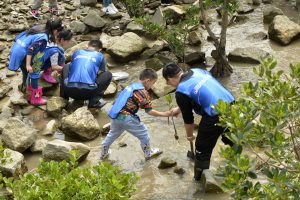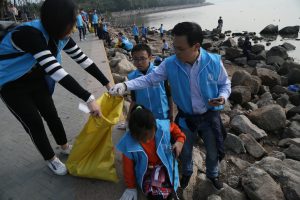Ocean conservation is one of the major themes of environmental protection, but there are very few non-profit organizations in China that focus their efforts on this topic.
Shenzhen Blue Ocean Environmental Protection Association is one of the very few, and we recently had the opportunity to speak with the Executive Secretary of Shenzhen Blue Ocean, Mr. Ma Haipeng to learn more about their work.
Mr. Ma Haipeng, Executive Secretary of Shenzhen Blue Ocean Environmental Protection Association, has dedicated the last 8 years in environmental protection and education efforts. He was named Shenzhen Top 10 young public welfare figures in 2016. Among his many roles, Mr. Ma is also a certified psychologist, an instructor at China Mountaineering Association, and the Founder of Shenzhen Yanye Nature Education Studio.
1. Hi Mr. Ma, could you introduce the history and background of your organization?
In early 2002, the first group of divers in Shenzhen organized a few marine environmental protection activities spontaneously and later proposed to establish a special association to protect the ocean, which was named “Blue Ocean”. Ms. Zhou Yunxin, the founding President, was the director of Shenzhen Ocean World Aquarium and one of the 2011 Top Ten ocean people in China. With everyone’s efforts, in July 2005, Blue Ocean has been officially approved as a register non-profit organization by Shenzhen Civil Affairs Bureau.
Blue Ocean is the first non-profit organization focuses on marine environmental protection in China. It is also a 5A-level NGO in China. Public donation receipt can be issued, but currently the receipt is not tax-deductible. The association has a board of directors, with secretariat as the executive body, and we have 7 full-time staff. Each member of the secretariat is not only responsible for the daily operation function including operation development, volunteer programs, finance and administration etc., and they are also responsible for leading the different environmental projects and activities.
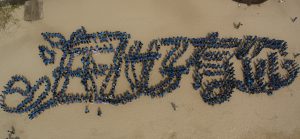
2. What are your main programs?
We have 3 main projects including Blue Homeland, Blue Coast, and Blue Classroom. We also have 2 major branded activities including International Children’s Ocean Festival, and International Ocean Cleaning Day.
- ‘Blue Homeland’ includes programs such as marine stock enhancement and planting mangrove trees.
- ‘Blue Coast’ includes public beach cleanup and scientific research beach cleanup programs. Which also covers the research of Shenzhen shoreline, coastline waste research, and beach cleanup leaders training etc.
- ‘Blue Classroom’ contains ‘blue lecturer’ training and classroom training delivery at the schools.
Each project is supported by a team of professional professors, experts, and engineers as volunteers on a long-term basis to ensure the effectiveness of the project. For example, the scientific release method of marine stock enhancement, the quarantine of mangroves saplings, and the compilation of Blue Classroom teaching materials which all need to be supported and well guided by our professional volunteer teams.
3. Would you please explain more about the concept of “marine stock enhancement”?
Marine stock enhancement is a set of management approaches to release cultured juveniles of several marine fish to replenish or increase abundance of wild stocks in open water areas like oceans, rivers and lakes. Due to polluted waters, overexploitation of offshore fish resources, the aquatic organisms and fishery resources of China offshore are seriously declining, some waters have shown an ecological desertification trend, and the offshore fishery resources are nearly exhausted. Based on the current status of aquatic resources and the ecological environment of the waters, marine stock enhancement is a measure to conserve resources and restore resources.
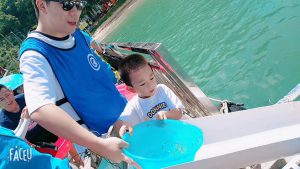
4. How do you do the program of marine stock enhancement? Which river basins do you usually do it?
Our main target of this program are government and enterprises. On one side, we will regularly conduct the program per the requirements of government. On the other side, we will help to organize related activities for enterprises who are interested in ocean protection programs and willing to donate for supporting this program.
This program is not an activity that can be carried out anytime and anywhere. Considering various factors such as water quality, surrounding conditions, such as whether there is interference from fishing grounds, and whether there is any danger of discharge, after various assessments and evaluation by experts, we mainly do this program in two places in Shenzhen – Dapeng bay and the beach area near Yantian district.
5. The purpose of mangrove planting?
Shenzhen is facing all the problems that coastal cities are facing, such as, coastal flooding, sea level rising and sea flood, etc. Mangrove forests are one of the most important ecosystems on the earth, providing many services to the ecosystem. As a coastal species, their adaptation to salty conditions can survive in salt marshes and tidal flats, replace salt marsh in tropical regions and support an abundant fauna. Meanwhile, mangrove act as a buffer zone, preventing soil and shoreline erosion and helps shield coastline from storm damage. Additionally, mangrove also can absorb carbon dioxide and store carbon in their sediments thereby lessening the impacts of global warming.
6. What does the mangroves planting program mainly include?
In Shenzhen, there are mainly two ways to plant mangrove. The first way is to plant the branches of the mangrove species Kandelia candel, which is a very simple and economical. The process only requires picking up the branches one week in advance and planting them directly on the day of planting activities. Another way is to buy mangrove seedlings and plant them. Either way can invite volunteers to participate and support the activities. We will share related knowledge to the participants and volunteers during the events.
Mangroves do not need much follow up maintenance, but after planting, we will conduct regular inspection of mangroves to check whether the planted mangroves are alive, and at the same time, avoid the destruction of the trees.

7. How to deal with the garbage collected after your beach cleanup activities?
At present, the only way is to return the garbage to the municipal waste treatment plant, which will be collected by municipal sanitation workers and sent to the municipal waste treatment plant. We have close cooperation with the beach management offices of more than 30 beaches that have carried out our beach cleanup projects. All of them are the Support Units of our project and will provide a complete set of support for garbage collection after our activities.
8. How do you conduct the ‘Blue Classroom’ program? Do you recruit volunteers from public or enterprises?
Blue Classroom materials are written by a team of ocean and educational experts who are also volunteers of our association. Our own volunteers participate in the program as the teachers after professional training by the experts. Generally, corporate volunteers cannot participate in the projects, because the volunteers in blue classroom are required to be more professional and more regular. Of course, we will open one or two seats for corporate staff if the company has a big passion to support the program, but volunteers must be able to complete the related professional training to ensure the professionalism and the quality of the class when delivering to the school and students.
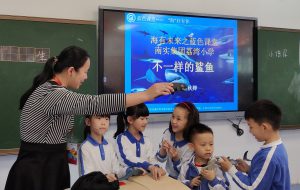
9. How do you evaluate your impact?
For different programs, we do both onsite evaluation and survey feedback, but we focus on more about the feedback from volunteers about the quality of the events and activities.
But we are also proud of sharing some data with you. In 2018, a total of 84 public beach activities were carried out, with 3,166 direct participants and 5,104 kilograms of Marine garbage removed. In terms of scientific research net beach, a total of 2,931 pieces of garbage weighing 5,315 kg were collected all year round. Mangrove tree planting events was organized 7 times in a year, with more than 500 civic volunteers participating. The Blue Classroom project has carried out 38 courses, benefiting more than 4,300 students.
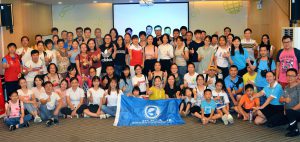
10. What’s your biggest challenge so far? Have you found any way to solve it?
Due to cost problems, most NGOs are not competitive in terms of payment, staff turnover is a challenge for many NGO, and it is also the big challenge of Blue Ocean.
For full-time staff, we hope to provide more learning and developing opportunities for them to keep the team more stable. For example, we work closely with some other ocean protection and strategy planning NGO, through the cooperation, our team can learn more professional knowledges and grow together.
At the same time, our main job is to encourage and develop stronger volunteer teams although we are a professional ocean protection organization. We treat ourselves more as a volunteer service organization and we hope to maximize the passion and ability of volunteers, train and encourage them from event participants to professional event organizers. There are about 10,000 citizen volunteers participating in our various services every year, and about 500 long-term volunteers are registered in our system, in addition to the long-term support of several experts and skill based volunteers. We hope this platform can get bigger and bigger.
11. What’s your plan for the next five year?
First of all, we will continue to have deep understanding of the basic situation of Shenzhen’s coastline. We will also continue to carry out the shore-based survey of Shenzhen’s coastline and the waste survey of it every year, so as to provide citizens and government departments with relevant knowledge and decision-making basis.
At the same time, we hope to improve volunteers’ initiative and ability to organize activities independently. We also hope to organize professional volunteers to provide more technical guidance for the projects. At the same time, we hope through our platform, more social forces will be mobilized to pay attention to current marine issues from different angles and channels and seek solutions together.
12. How can our readers and corporate companies support your organization and programs?
First of all, we welcome individual and corporate employees to be our volunteers. We do not want to rely on the donation of single large enterprises or government departments to support our organization.
Instead, we hope that through the dissemination of Marine protection awareness, people can start action from individuals and collect the power to make a bigger impact.
In addition, we also expect skill-based volunteers to actively support our daily work, such as website construction, editing and communication, etc.
Of course, we also hope to become a social service platform for small and medium-sized enterprises. We welcome donations from enterprises, and as return we will provide a good social services platform and arrange related environmental protection activities and projects for them.
13. How can people contact with your organization?
You can contact us or know more about us through below:
Official Email Address: 1929764069@qq.com
Website:www.szboca.org
Sina Weibo:http://weibo.com/szboca or @蓝色海洋环境保护协会/@szboca
Tencent Weibo:http://t.qq.com/szboca or @蓝色海洋环境保护协会/@szboca
QQ group:98010004

